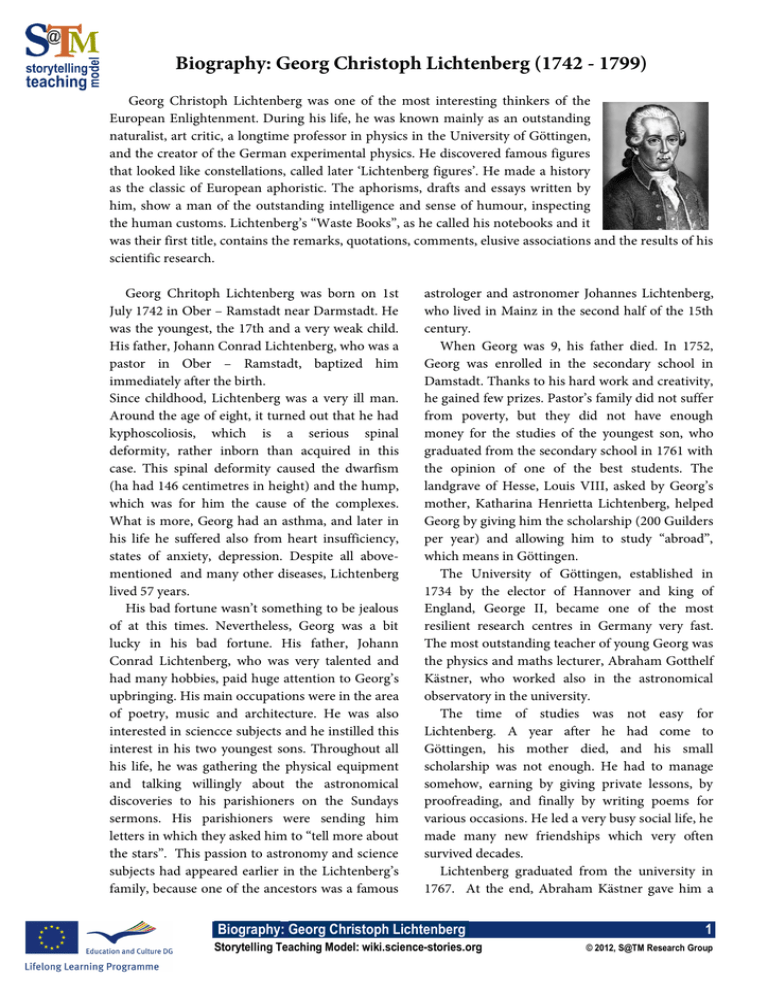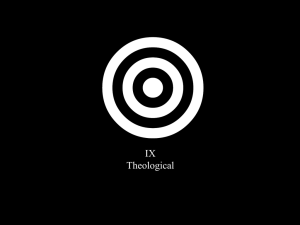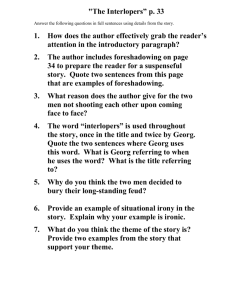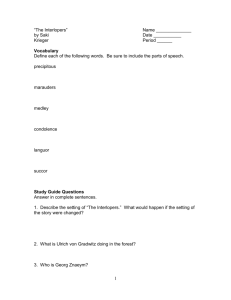Biography: Georg Christoph Lichtenberg (1742
advertisement

Biography: Georg Christoph Lichtenberg (1742 - 1799) Georg Christoph Lichtenberg was one of the most interesting thinkers of the European Enlightenment. During his life, he was known mainly as an outstanding naturalist, art critic, a longtime professor in physics in the University of Göttingen, and the creator of the German experimental physics. He discovered famous figures that looked like constellations, called later ‘Lichtenberg figures’. He made a history as the classic of European aphoristic. The aphorisms, drafts and essays written by him, show a man of the outstanding intelligence and sense of humour, inspecting the human customs. Lichtenberg’s “Waste Books”, as he called his notebooks and it was their first title, contains the remarks, quotations, comments, elusive associations and the results of his scientific research. Georg Chritoph Lichtenberg was born on 1st July 1742 in Ober – Ramstadt near Darmstadt. He was the youngest, the 17th and a very weak child. His father, Johann Conrad Lichtenberg, who was a pastor in Ober – Ramstadt, baptized him immediately after the birth. Since childhood, Lichtenberg was a very ill man. Around the age of eight, it turned out that he had kyphoscoliosis, which is a serious spinal deformity, rather inborn than acquired in this case. This spinal deformity caused the dwarfism (ha had 146 centimetres in height) and the hump, which was for him the cause of the complexes. What is more, Georg had an asthma, and later in his life he suffered also from heart insufficiency, states of anxiety, depression. Despite all abovementioned and many other diseases, Lichtenberg lived 57 years. His bad fortune wasn’t something to be jealous of at this times. Nevertheless, Georg was a bit lucky in his bad fortune. His father, Johann Conrad Lichtenberg, who was very talented and had many hobbies, paid huge attention to Georg’s upbringing. His main occupations were in the area of poetry, music and architecture. He was also interested in sciencce subjects and he instilled this interest in his two youngest sons. Throughout all his life, he was gathering the physical equipment and talking willingly about the astronomical discoveries to his parishioners on the Sundays sermons. His parishioners were sending him letters in which they asked him to “tell more about the stars”. This passion to astronomy and science subjects had appeared earlier in the Lichtenberg’s family, because one of the ancestors was a famous astrologer and astronomer Johannes Lichtenberg, who lived in Mainz in the second half of the 15th century. When Georg was 9, his father died. In 1752, Georg was enrolled in the secondary school in Damstadt. Thanks to his hard work and creativity, he gained few prizes. Pastor’s family did not suffer from poverty, but they did not have enough money for the studies of the youngest son, who graduated from the secondary school in 1761 with the opinion of one of the best students. The landgrave of Hesse, Louis VIII, asked by Georg’s mother, Katharina Henrietta Lichtenberg, helped Georg by giving him the scholarship (200 Guilders per year) and allowing him to study “abroad”, which means in Göttingen. The University of Göttingen, established in 1734 by the elector of Hannover and king of England, George II, became one of the most resilient research centres in Germany very fast. The most outstanding teacher of young Georg was the physics and maths lecturer, Abraham Gotthelf Kästner, who worked also in the astronomical observatory in the university. The time of studies was not easy for Lichtenberg. A year after he had come to Göttingen, his mother died, and his small scholarship was not enough. He had to manage somehow, earning by giving private lessons, by proofreading, and finally by writing poems for various occasions. He led a very busy social life, he made many new friendships which very often survived decades. Lichtenberg graduated from the university in 1767. At the end, Abraham Kästner gave him a Biography: Georg Christoph Lichtenberg Storytelling Teaching Model: wiki.science-stories.org 1 © 2012, S@TM Research Group very good opinion that was addressed to the superintendent of the Hesse University in Geßen, in which he paid attention mainly to the talent of the young scholarship holder of “interesting lecturing, which is a very desired benefit of a scholar”. The Lichtenberg’s lectures became famous in whole Germany, mainly because of the scientific demonstrations. Lichtenberg claimed that “the physical experiment during which one can hear a bang, is always worth more than the experiment that is performed in silence”. In August, 1767, he was honoured with the title of the professor of mathematics and English by Louis VIII in the University of Geßen, but he stayed in Göttingen. Lichtenberg was famous and respected, but he sometimes caused fear, sometimes amusement. Especially that he appreciated the experiments ending with loud explosions, adding that “sometimes the bang is so loud that the dogs in the neighbouring parish start to bark”. In his experiments helped him Mikołaj Bogusław Ciechański (1737 – 1828), who was a Polish man from Słuck. Financial affairs had never been important for Georg Christoph. He did not earn enough for a house, or even a flat, and till the end of his life he remained the tenant of his friend and publisher, Dietrich, for whom he edited “the Göttingen Pocket Calendar” in return. He paid personally also for the physical equipment, for example for the first vacuum pump in Germany he paid 450 thalers, which was more than his annual university salary. In spring 1770 he travelled to London for the first time. His stay was short, but fruitful, because on April. 22nd he was welcomed in the royal observatory by George III himself and he clearly gained king’s sympathy. Due to the king’s will Lichtenberg was given the nomination of the extraordinary professor in Göttingen. Four years later he came to England, where he stayed longer. Very often he was a guest of king, who invited him to the dinners in the narrow group of friends. In August 1777, Johann Polycarp Erxleben died, who was physics, chemistry and natural history professor, and Lichtenberg’s friend from the students years. In 1767 they analysed a small 2 earthquake in Göttingen together. Lichtenberg took over the faculty after the dead of scholar, he published and fundamentally completed his unusually popular at this time physics and natural history textbook. Lichtenberg was planning to write his own textbook, but he never did that. Although, he had never published any bigger work in natural history with his name, he was considered as one of the most outstanding contemporary scholars. He became a member of the Royal Society and the St. Petersburg Academy of Sciences, and the Leiden University proposed him the professor post, but Georg did not take it, because he had been already very ill. In 1777 during the walk he met almost 12-yearold florist, Maria Dorothea Stechard, who made on him huge impression. Less than a year later, with the approval of her mother, he employed her as a servant. After Easter in 1780, Maria moved to Lichtenberg’s flat to live there permanently and she became his wife “without the priestly blessing”, but she died in 1782. Then, Lichtenberg married his ex-servant, Margarethe Kellner, and she gave him eight children. On the hills surrounding Göttingen Lichtenberg conducted the experiments on the newest contemporary innovation – lightning protection rod. In May, 1780, he installed it in his suburban house. Unfortunately, he was not the first in Germany – doctor Johann Albert Heinrich from Hamburg and the abbot Johann Ignaz Felbinger from the Silesian Żagań were the first in 1769. In December, 1795, Georg came back to Göttingen and soon after that he accidentally discovered something very important. One day he noticed that the particles of dust gathering on the cover of his electrophorus were arranging in strange, constellation-like shapes, named later the Lichtenberg figures. In February, 1778 he presented the paper on this topic during the session of the Göttingen Society of Science, but he was not able to explain fully the reason of this phenomenon. The discoverer himself supposed that “amazing creation of these figures seems to show the essential difference between the positive (+) and negative (-) electricity”. He had also the feeling that the electricity will be used in the future Biography: Georg Christoph Lichtenberg Storytelling Teaching Model: wiki.science-stories.org in communication: “with help of the electric wires maybe it will be possible to send signals, determine the distances to the near places, and so on. It could be possible to use currents for that, at least on certain sections.” So far, Lichtenberg had to be satisfied with the very simple experiments, for which, “with huge benefit” he used also his cat, describing: “I put it down on the table (isolated), I rub it heavily, and I touch it with the disc of small electrophorus, which gives the sparks as big as ¾ inch. Lichtenberg supposed correctly that two fighting theories of light – corpuscular and waving - can be joined together. He was defending the phlogiston theory, fighting and laughing at Lavoisier’s theory. Georg Christoph Lichtenberg died on 24th February 1799, aged 57. His grave is in the St. Bartholomew in Göttingen. As physician famous during his life, he was almost completely forgotten after his death. J.W. Goethe wrote about him: “Where Lichtenberg jokes, a serious problem is hidden.” References: Hewitt P. G., Fizyka wokół nas, Wydawnictwo Naukowe PWN, Warszawa 2010 http://de.wikipedia.org/wiki/Georg_Christoph_Lichtenberg http://www.br.de/radio/bayern2/sendungen/radiotexte-amdienstag/georg-christoph-lichtenberg102.html Turlo J. (ed.), Eksperymenty historyczne w nauczaniu fizyki, Top Kurier, Toruń 2001 Zatorski T., Georg Christoph Lichtenberg: Pochwała wątpienia, Wydawnictwo słowo/obraz terytoria, Gdańsk 2005 Biography Georg Christoph Lichtenberg is based, in part on Historical Background: Electrophorus written by Peter Heering. Biography: Georg Christoph Lichtenberg was written by Dawid Basak with the support of the European Commission (project 518094-LLP-1-2011-1-GR-COMENIUS-CMP) and Polish Association of Science Teachers, Poland. This publication reflects the views only of the author, and the Commission cannot be held responsible for any use which may be made of the information contained therein. Biography: Georg Christoph Lichtenberg Storytelling Teaching Model: wiki.science-stories.org 3 © 2012, S@TM Research Group


